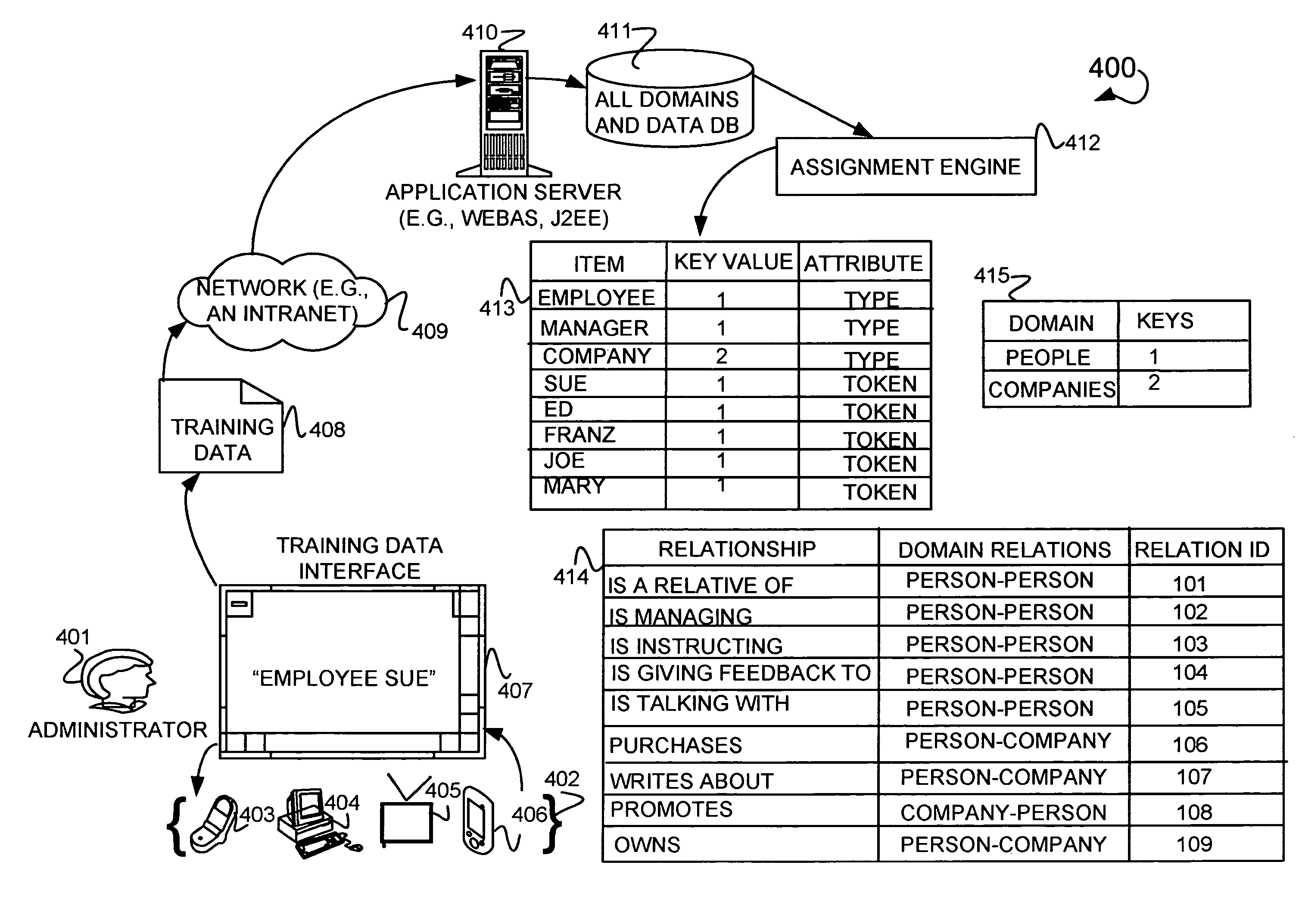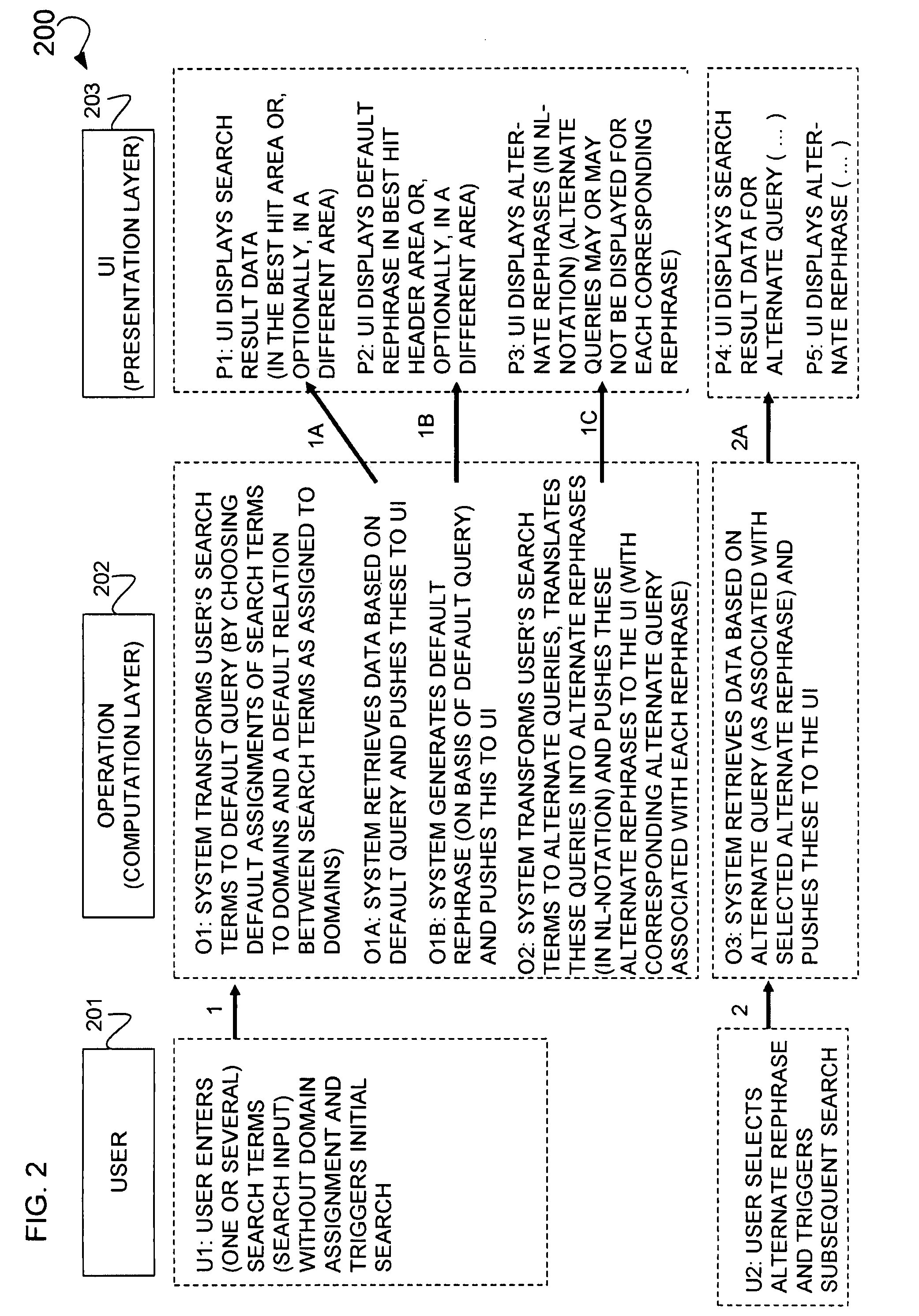Mixed initiative semantic search
- Summary
- Abstract
- Description
- Claims
- Application Information
AI Technical Summary
Problems solved by technology
Method used
Image
Examples
example domains
and Sub-Domains
[0045]In some embodiments, a domain is a synonym for category or concept, and likewise sub-domains are sub-categories, or sub-concepts. That is, for example, a term that can be assigned to a domain may also be assigned to a sub-domain, and during the parsing of a search query the query may be assigned or even parsed as part of a domain or sub-domain. Further, in some embodiments, a domain may be a category which, in turn, may be thought of as a set of entities that belong to the same type. For example, a user may enter any of the following search statements including ‘term1 term2’ (e.g., focusing here only on assignment of term1) such that a query 1 of “Mercedes with ID 4711-999 Barcelona” results in the following parsing and domain assignment: on domain level (e.g., ‘Mercedes with ID 4711-999’ ISA vehicle; Barcelona ISA city) or, optionally on the sub-domain level (e.g., “Mercedes with ID 4711-999′ ISA car; Barcelona ISA city”). Further, a query 2 of “car Barcelona” ...
example relations
[0046]In some embodiments, while hierarchical relations between domains are pervasive in ontologies / semantic webs, usually relations are considered to be “unidimensional”. Here, however, multi-dimensional relations may be implemented such that individual terms (e.g., as entered by users as part of a search query) can each be assigned to concepts of varying hierarchical levels (e.g., can be assigned to concepts or sub-concepts, and as a consequence, different types of relations with respect to their hierarchical relationship to each other may be considered). For example, based upon the following assignment: term1 ISA airplane; term2 ISA city, the following relations can be asserted: flies to, lands at airport of. And again, based upon the following assignments: term1 ISA vehicle; term2 ISA city, the following relations can be asserted: moves to; arrives at destination. In some embodiments, “moves to” can be considered to be a superordinate relation as compared to, for example, “flies...
example searches
[0048]With regard to the actual searches that are conducted, users may be able to conduct searches and retrieve search results not based upon text containing the literal text string, e.g., “manager Sue,” but rather users may be able to retrieve search results relating to “manager who reports to Sue”, “Sue reports to manager”, or some other set of search results based upon training data or based upon data pre-existing in an enterprise database. And again, in certain cases, the name of a manager may be supplied as a search result in response to the search queries “manager who is supervising Sue” or “manager who reports to Sue”.
[0049]In the above examples, “Sue” and “Manager” may be tuples in one or more databases, and “who reports to” and “reports to” may be semantic relations supplied to link these tuples. For example, various semantic queries may be generated using the search phrase “manager Sue,” where “manager” (e.g., a term #1) and “Sue” (e.g., a term #2) are parsed out of the se...
PUM
 Login to View More
Login to View More Abstract
Description
Claims
Application Information
 Login to View More
Login to View More - R&D
- Intellectual Property
- Life Sciences
- Materials
- Tech Scout
- Unparalleled Data Quality
- Higher Quality Content
- 60% Fewer Hallucinations
Browse by: Latest US Patents, China's latest patents, Technical Efficacy Thesaurus, Application Domain, Technology Topic, Popular Technical Reports.
© 2025 PatSnap. All rights reserved.Legal|Privacy policy|Modern Slavery Act Transparency Statement|Sitemap|About US| Contact US: help@patsnap.com



